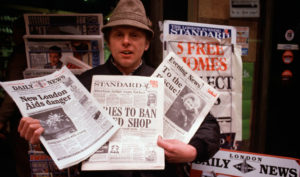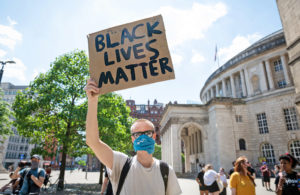The Star Wars franchise has always been a cultural mirror, with each manifestation reflecting the fears, hopes, and political themes of the moment it was created. The original 1977 film was steeped in the anxieties of a postwar landscape; the late-Nineties prequel trilogy is imbued with the lighthearted confidence (and excessive CGI use) of the pre-social internet era. And as its latest property, Obi Wan Kenobi, is released, a post from the official Star Wars Twitter account launches in to the culture wars.
“We are proud to welcome Moses Ingram to the Star Wars family and excited for Reva’s story to unfold,” it read, alongside a photo of its newest cast member. “If anyone intends to make her feel in any way unwelcome, we have only one thing to say: we resist.”
And then, just in case you didn’t get the message, there was a follow-up tweet: “There are more than 20 million sentient species in the Star Wars galaxy, don’t choose to be a racist.”
Suggesting millions of Star Wars fans are a bunch of racists-in-waiting might seem like a peculiar PR strategy. But if you were to plot the marketing trajectory of Star Wars alongside the fall of traditional journalism, a pattern would begin to emerge.
Today’s predominant mode of cultural engagement began incubating on Tumblr around 2010, spread to mainstream media in the lead-up to America’s 2016 election, and now dominates the entire cultural apparatus up to and including Hollywood itself. It owes much to the 2008 recession, and the mass layoffs in media which fundamentally transformed how news was covered.
Imagine a horde of freshly unemployed veteran writers, alongside new journalism grads, desperately trying to claw out a livelihood in a world where writing had been completely devalued. (It was not unusual, at this time, to be told that the job you were applying for paid not in money but “exposure”.) Gone was the $2-per-word magazine staff writer position; gone was the local shoe-leather reporting job that might launch a lifelong career. Now, a writer’s best option was freelance blogging, churning out listicles and aggregated new stories at $15 a pop — and with a quota, which at some outlets ran as high as 20 posts per day.
The pressure to produce content on such an accelerated timeline spawned a lot of half-arsed, hastily-executed work (“10 Times Brad Pitt’s Butt Made Me Want To Die: A List In GIFs”) but also created a constant scramble for something, anything, to write about. Social media, then in its infancy, was a lifesaver: as a reporter at MTV News, I could curate a quick roundup of Twitter or Tumblr reactions to last night’s Game of Thrones episode in less than 20 minutes, which allowed me to meet my quota while also prioritising more interesting, time-consuming work (for instance, getting a trauma surgeon to assess whether it was actually, medically possible for The Mountain to crush Oberyn Martell’s skull like a grape).
At the time, this interface between reporters and random posters was both friendly and fully symbiotic: the writers got free content, the posters increased their internet clout. And crucially, nobody took any of it all that seriously; even being cruel could earn you a coveted place in the Celebs Read Mean Tweets roundup on Jimmy Kimmel Live.
But, in 2014, as cash-strapped media outlets chose to prioritise opinion journalism (quick and cheap) over investigative reporting (time-consuming and expensive), the news cycle became increasingly outrage-driven, and our thinking about the type of post that was deemed worthy of coverage changed. The saga of Justine Sacco had recently introduced a hungry populace to the joys of playing hunt-the-racist on Twitter. The US was becoming more tribal, and art, in turn, more political. The ridiculous culture war known as Gamergate consumed the discourse for months on end, as did a massive controversy over the new, all-female Ghostbusters reboot. Liking this movie — even just liking the idea of it — meant you were one of the good guys. Disliking it, on the other hand, marked you as not just a critic, but a Bad Person.
The new Star Wars trilogy, then, was perfectly positioned to become a flashpoint in this newest culture war — a war that directly benefited a media economy in which controversy meant clicks. Its first piece of promotional material could not have been more perfectly designed to provoke the ire of the franchise’s less-enlightened fans: a teaser, released in November 2014, featuring the actor John Boyega dressed as a stormtrooper.
This is not to say that the Star Wars publicity department wanted racists to take aim at the trailer, but given the number of pieces about “racist Star Wars fans” which followed over the next 24 hours, they would also have had to be idiots not to realise they’d stumbled on marketing gold.
At the same time, celebrities had cottoned on to the value of clapping back on social media. Responding to a random dickhead was no longer undignified or beneath them, but the quickest, easiest way to get positive press. So when Boyega made an Instagram post addressing the black stormtrooper controversy, the internet went wild.
A representative post about Boyega’s clapback reveals how easy it was to map this new, slightly sanctimonious mode of media coverage onto the existing social media-based story model. All you needed was a vaguely clickbaity headline (“JOHN BOYEGA SHUT DOWN RACIST ‘STAR WARS’ HATERS WITH FOUR SIMPLE WORDS”), followed by 250 lightly editorialised words about the incident, followed by two embedded tweets showcasing the alleged racism, rounded off with Boyega’s post and a boilerplate link back to the Force Awakens teaser.
But what it also reveals, in hindsight, is how this mode of coverage blurred the boundaries between identifying a trend and manufacturing one. The two embedded tweets in that piece had a total of 11 retweets between them, suggesting that the sentiment within them were anything but popular. If not for the existing practice of trawling Twitter for “people are saying” stories — and if not for the absurd expectation that journalists should post new material every hour — there would never have been any reason to dig them up. The racist haters would have simply languished in obscurity, their tweets lost to the sands of time.
This would have been a good time for culture writers to step back, both from the quota model of journalism and from its engagement with stupid social media controversies. But this was 2015, which was followed by the year in which progressives abandoned all pretence of being culture war noncombatants and went all-in on sneering contempt. The purest form of this shift is Molly Fitzpatrick’s article, “Angry baby-men hate the new Ghostbusters trailer”.
In hindsight, the “baby-men” article marked a point of no return. The ossified smugness of it, the right-side-of-history certainty, the way that books and movies and television and music now sorted automatically on political grounds into things one ought to be either for or against. By the time the new Ghostbusters was actually released, the criticism of it was not criticism so much as a celebration of its mere existence, so that any assessment of whether it was good or not became entirely irrelevant. (It was, for the record, not good.)
And Star Wars was an opportunity like no other to stick it to the baby-men. It was about strong female characters, and intergalactic diversity, and standing up against the fascist forces of the Trump admi… uh, I mean, the Empire. By the time The Last Jedi came out in December 2017, the American Left had so thoroughly fused its pop culture with its politics that it was no longer possible to discern if the “Resistance” movement people kept referring to was the one with the spaceships, or the one with those ludicrous pink hats. By 2020, every Star Wars news cycle included stories about how the franchise’s forays into diversity continued to infuriate its toxic fanbase.
This brings us back to Obi Wan Kenobi and Moses Ingram, a story whose trajectory is as good an example as any of how Hollywood has learned to leverage this aspect of the discourse. On 22 May, Ingram told The Independent that she’d been warned about racist Star Wars fans by none other than the execs at Lucasfilm, and took a light jab at the lack of diversity in the franchise: “If you’ve got talking droids and aliens but no people of colour, it doesn’t make sense.” The Independent led with that quote, and the interview was dutifully re-reported over the next few days by multiple outlets — under such provocative headlines as “Lucasfilm Warned ‘Obi-Wan’ Star Moses Ingram About Racist ‘Star Wars’ Trolls”. And within a week, Ingram began posting screenshots of abusive messages she’d received on Instagram, including one calling her a “diversity hire”.
From there, it was a short distance to the “don’t be racist” tweet from the official Star Wars account. As of this writing, it has been retweeted upwards of 30,000 times, and dozens of mainstream media outlets from NPR to the Daily Show have run at least one story about it.
None of this is to say that racist Star Wars fans do not exist. They do; the question is whether they are emboldened, even incentivised, by this continued, bizarre symbiosis with an outrage-driven media that relies on them for content. Consider one of the top citations in these stories, a YouTube video titled “Obi-Wan Series Is Going To Be AWFUL Because It’s Hiding Behind Diversity AGAIN!”, apparently made in response to Ingram’s 22 May comments in the Independent. The video is objectively offensive (the word “darkies” appears in the thumbnail), and the creator, an account named MechaRandom42, seems to specialise in intentionally inflammatory content with an anti-woke bent. But it is content that people mostly don’t watch: within the past month, she has posted multiple videos per week, most of which have paltry view counts in the 1,000-2,000 range.
The official Obi Wan Kenobi trailer posted a month ago by Disney has been viewed 11 million times. The “hiding behind diversity” video, on the other hand, has 13,000 views — the bulk of which came after journalists started citing it in their coverage of the controversy.
Who benefits from this? The trolls do, of course. They’re getting exactly what they want, their status and influence growing with every indignant squawk, every angry celebrity video response. But they’re not the only ones. A media class that makes its living on outrage gets a story that does numbers. Moses Ingram gets an outpouring of support and waves of positive press coverage. The studio execs behind Obi Wan Kenobi get the warm, fuzzy feeling that comes from persuading a bunch of impressionable people that the best way to signal their moral correctness is by putting more money in Disney’s pocket. Everybody wins.
Except the art, of course. In a culture that cannot conceive of appreciating something you love unless it’s part of a righteous backlash against the angry baby-men you hate, art loses every time.
Disclaimer
Some of the posts we share are controversial and we do not necessarily agree with them in the whole extend. Sometimes we agree with the content or part of it but we do not agree with the narration or language. Nevertheless we find them somehow interesting, valuable and/or informative or we share them, because we strongly believe in freedom of speech, free press and journalism. We strongly encourage you to have a critical approach to all the content, do your own research and analysis to build your own opinion.
We would be glad to have your feedback.
Source: UnHerd Read the original article here: https://unherd.com




